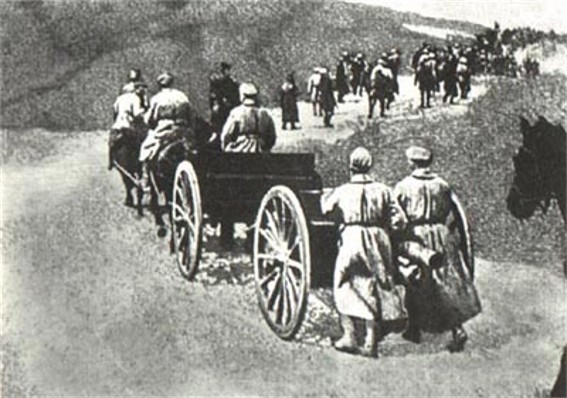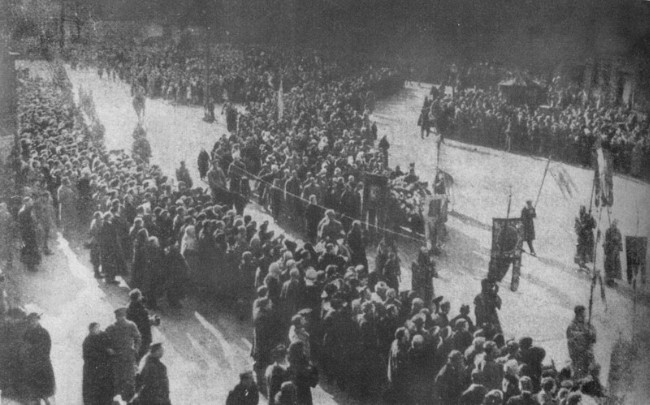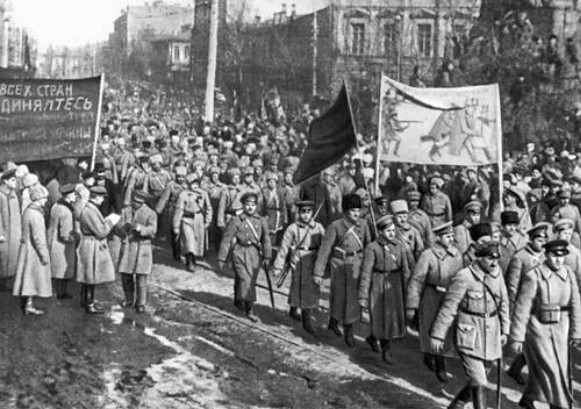Ukrainian-Soviet War, 1917–21
Ukrainian-Soviet War, 1917–21. A military struggle for control of Ukraine waged intermittently in 1917–21 by Ukrainian independentist forces and pro-Bolshevik elements seeking to establish Soviet rule. The struggle began shortly after the October Revolution of 1917. Notwithstanding the creation of the Ukrainian National Republic (UNR) on 20 November 1917, the Bolsheviks planned to seize power in Ukraine with the aid of Russian or Russified urban elements, Russian garrisons, and army units stationed near the front. Their armed uprising in Kyiv on 11 December 1917 was unsuccessful, however, and the Bolshevized army units were deported from Ukraine in stages. A pro-Bolshevik force under Yevheniia Bosh moving in on Kyiv was also disarmed by Ukrainian troops under Pavlo Skoropadsky near Zhmerynka and then sent off to Russia.
December 1917 to April 1918. Hostilities broke out in Ukraine after a series of diplomatic maneuvers. On 17 December 1917 the Petrograd-based Council of People's Commissars issued an ultimatum demanding that Bolshevik troops be granted the legal right to be stationed on Ukrainian soil. The ultimatum was rejected by the UNR. The Bolsheviks countered by proclaiming their own Ukrainian government (see the People's Secretariat) based in Kharkiv on 25 December, and then proceeded with a campaign to establish effective military control over Ukraine. The Ukrainian forces at that time consisted of a small volunteer detachment and several battalions of the Free Cossacks. The pro-Soviet forces in Ukraine included Russian army regulars stationed at the front, a number of garrisoned units, and Red Guard detachments composed of laborers from Kharkiv gubernia and the Donbas. Their main strength, however, lay in a large force of Red Guards from Russia, which had been stationed along the Ukrainian border. On 25 December that 30,000-strong army, led by Volodymyr Antonov-Ovsiienko, set off in four groups from Homel and Briansk toward Chernihiv–Bakhmach, Hlukhiv–Konotop, and Kharkiv–Poltava–Lozova.
The invasion by pro-Soviet forces was accompanied by uprisings initiated by local Bolshevik agitators in cities throughout Left-Bank Ukraine. The Bolshevik forces occupied Kharkiv (26 December), Lozova and Katerynoslav (now Dnipro, 9 January 1918), Oleksandrivske (now Zaporizhia, 15 January), and Poltava (20 January). The Briansk group captured Konotop (16 January) and Hlukhiv (19 January). On 27 January the Bolshevik army groups converged on Bakhmach and then set off under the command of Mikhail Muravev to take Kyiv.
The Central Rada prepared for the defense of the capital by sending advance forces of volunteers to Poltava and Bakhmach. One of those, the Student Battalion of Sich Riflemen, was annihilated by a vastly larger (4,000 troops) Bolshevik force at the Battle of Kruty, 130 km northeast of Kyiv, on 29 January. As the Soviet advance continued, an attempt was made to take Kyiv through an uprising organized by non-Ukrainian workers based at the Arsenal plant. Fighting broke out on 29 January and continued until 4 February, when the revolt was put down by a newly formed contingent of the Sich Riflemen and the Free Cossacks. Meanwhile the Bolshevik expeditionary force continued to move on the capital from Bakhmach and Lubny. On 8 February the Ukrainian government was forced to evacuate the city. Soviet troops under Mikhail Muravev's command entered Kyiv on 9 February and then carried out brutal reprisals against the Ukrainian civilian population.
After taking Kyiv the Bolsheviks launched an offensive in Right-Bank Ukraine, where they were engaged in battle mainly with Free Cossack forces. They moved into Volhynia and Podilia (led by the former Russian Seventh Army), where they took Proskuriv, Zhmerynka, Koziatyn, Berdychiv, Rivne, and Shepetivka and forced the Ukrainians back to a Zhytomyr–Korosten–Sarny defensive line.
The tide changed following Ukraine's signature of the Peace Treaty of Brest-Litovsk and the entry of German and Austrian troops into the conflict in late February as allies of the Central Rada. With a Ukrainian command of Gen K. Prisovsky and Symon Petliura the combined force rolled the Bolshevik troops out of Right-Bank Ukraine's centers, such as Zhytomyr, Berdychiv, Koziatyn, and Bucha, before regaining Kyiv on 1 March. Through March and April the German and Austrian armies took control of Left-Bank Ukraine, and the troops of Petro Bolbochan and Volodymyr Sikevych took the Crimea and the Donets Basin. Alarmed by the changed military situation, Vladimir Lenin ordered his representative in Ukraine, Grigorii Ordzhonikidze, to Ukrainize (at least ostensibly) the predominantly Russian forces of Volodymyr Antonov-Ovsiienko and Mikhail Muravev in a bid for more popular support. The maneuver proved unsuccessful. Continuing military setbacks gave Soviet Russia little choice but to comply with the articles of the Treaty of Brest-Litovsk and to sign a preliminary peace with the Ukrainian government on 12 June 1918.
December 1918 to December 1919. The second phase of the Ukrainian-Soviet War began with the fall of the German-supported Hetman government to the forces of the Directory of the Ukrainian National Republic. The Bolsheviks took advantage of the unsettled situation by forming a Provisional Workers' and Peasants' Government of Ukraine on 20 November 1918 and starting a military advance into Ukraine in December with an army led by Volodymyr Antonov-Ovsiienko, Joseph Stalin, and Volodymyr Zatonsky. The Directory protested the aggression, with diplomatic notes sent to the Soviet government on 31 December 1918 and on 3, 4, and 9 January 1919. Not having received a reply, the Directory was compelled to declare war against Russia on 16 January. The Ukrainian forces at that time consisted of two regular troop formations, the Zaporozhian Corps and the Sich Riflemen, as well as partisan detachments (see Partisan movement in Ukraine, 1918–22) led by otamans, such as Nestor Makhno, Nykyfor Hryhoriv, and Danylo Zeleny. The otamans, however, were politically unreliable and occasionally sided with the Bolsheviks.
In December 1918 and January 1919 the Bolshevik expeditionary force, aided by some of the otamans, captured Left-Bank Ukraine, and on 5 February it closed in on Kyiv, where it forced the Ukrainian government once more to flee from the capital. The Soviet attack proceeded on several fronts. A northern group moved along a Mozyr–Korosten and Lunynets–Sarny–Rivne line in an attempt to cut off the Army of the Ukrainian National Republic from the Ukrainian Galician Army (UHA) to the west. A southern group proceeded from the Kremenchuk-Katerynoslav region through Znamianka toward the Birzula–Koziatyn–Zhmerynka line in an effort to cut off the UNR troops from possible reinforcement by Entente forces. At a critical moment Otaman Nykyfor Hryhoriv threw his support behind them. The third Bolshevik army group proceeded from Kyiv to the Berdychiv–Koziatyn–Zhmerynka line in an effort to keep the northern and southern wings of the UNR Army divided.
The UNR army launched a counteroffensive in March, in which it defeated the Soviet forces along the Berdychiv–Koziatyn line and advanced almost to Kyiv, thereby effectively cutting off any possibility that the Soviets might march through Romania to Hungary in order to aid the Béla Kun regime. The Bolshevik forces retaliated in April (after the withdrawal of Entente troops) by marching on Zhmerynka and dividing the UNR army's southern flank from the force's main body. The southern group subsequently lost the support of Otaman Omelian Volokh and was forced to retreat into Romania, where it was disarmed (eventually returning through Galicia to Volhynia). At the same time, the UNR army was pushed back to a small parcel of territory approx 40–50 km wide in the Dubno-Brody region of southwestern Volhynia. Its position was weakened further with a coup attempt by one of its commanding officers, Volodymyr Oskilko.
The UNR Army's fortunes improved as Ukrainian peasants, disgruntled by the Bolsheviks' anti-Ukrainian policy and high requisition quotas, started to replenish insurgent ranks. But before the army itself could regroup, it faced an assault by Polish forces in the Lutsk region and advances from the Red Army in the north and southeast that took Rivne, Shepetivka, Proskuriv, and even Kamianets-Podilskyi. The UNR then reached a peace agreement with the Poles and reorganized its army into four groups—the Sich Riflemen and the Zaporozhian Corps, Volhynian Corps, and Southwestern Corps—with a total of approx 15,000 soldiers. In early June the UNR forces launched an offensive which retook Podilia and Kamianets-Podilskyi. The Red Army retaliated at the end of the month with a campaign that regained Proskuriv (5 July) and approached Kamianets-Podilskyi, which had been made the UNR's provisional capital. The UNR was then strengthened by the arrival of Yurii Tiutiunnyk with troops formerly under Nykyfor Hryhoriv, who had worked his way through the Reds' southern flank. The UNR Army launched a campaign which pushed the Bolshevik forces back to the Horodok [see Horodok (Khmelnytskyi oblast)]–Yarmolyntsi–Sharhorod–Dunaivtsi–Nova Ushytsia–Vapniarka line before being joined by UHA troops who had crossed the Zbruch River on 16–17 July; their arrival brought together a combined Ukrainian force of nearly 85,000 regulars and 15,000 partisans.
The subsequent campaign to take Kyiv proceeded with victories in Vinnytsia (12 August), Khmilnyk, Yaniv, Kalynivka, and Starokostiantyniv (14 August), Berdychiv (19 August), and Zhytomyr (21 August). On 31 August the Ukrainian troops entered Kyiv, only to discover that soldiers from Anton Denikin's Volunteer Army had arrived at the same time. Hostilities between the two forces were narrowly averted when the combined Ukrainian forces pulled out of the city. The Bolsheviks took advantage of the Ukrainians' standoff with Denikin's troops to move some of their forces from the Katerynoslav region to Zhytomyr. Meanwhile the leadership of the UNR and UHA split over how to deal with Denikin, a situation exacerbated by an outbreak of typhus among the troops. The UHA leadership finally made a separate peace with the Volunteer Army on 6 November. The military situation had worsened as Bolshevik forces, which had made substantial gains in Right-Bank Ukraine's areas formerly controlled by Denikin's troops, and the Poles moved into the western reaches of Ukraine. By the end of November the government and the UNR Army found themselves hemmed in by Soviet, Polish, and Volunteer Army troops. At a conference on 4 December the army decided to suspend regular military operations in favor of underground partisan warfare.
December 1919 to November 1920. The UNR Army under the command of Mykhailo Omelianovych-Pavlenko carried out an underground operation known as the First Winter Campaign in the Yelysavethrad (now Kropyvnytskyi) region against the Soviet 14th Army from 6 December 1919 to 6 May 1920. In addition to that action the UNR government concluded the Treaty of Warsaw on 22 April, and then launched a joint offensive with Polish troops against the Bolsheviks. By 7 May a Ukrainian division under the command of Marko Bezruchko entered Kyiv, but the success was short-lived. A Red Army counteroffensive led by Semen Budenny pushed the combined forces back across the Zbruch River and past Zamość toward Warsaw. After the decisive battle of 15 September the Polish-Ukrainian forces threw the Bolshevik contingent back as far as the Sharhorod–Bar–Lityn line in Podilia. The Poles concluded a separate peace with the Soviets on 18 October. The 23,000-strong UNR force continued fighting until 21 October, when its position became untenable. The UNR Army crossed the Zbruch River into Polish-controlled Galicia, where they were disarmed and placed in internment camps.
November 1921. The final military action of the UNR against the Soviets was a raid in November 1921 known as the Second Winter Campaign. The intent of the action was to provide a catalyst for the formation of partisan groups which would incite a general uprising against the Bolsheviks in Ukraine. The commander of the action was Yurii Tiutiunnyk. Two expeditionary forces were established, Podilia (400 men) and Volhynia (800 men). The Podilia group advanced as far as the village of Vakhnivka, in the Kyiv region, before returning to Polish territory through Volhynia on 29 November. The Volhynia group took Korosten and advanced as far as the village of Leonivka in the Kyiv region. On its return march it was intercepted by a Bolshevik cavalry force under the command of Hryhorii Kotovsky, however, and routed in battle near Mali Mynky on 17 November. Of the 443 soldiers captured by the Soviets 359 were shot on 23 November near the town of Bazar, in the Zhytomyr region, and 84 were passed on to Soviet security forces.
The Second Winter Campaign brought the Ukrainian-Soviet War to a definite conclusion. The partisan movement in Ukraine, 1918–22 remained active until mid-1922, but conventional military action by regular troops had ceased.
BIBLIOGRAPHY
Kapustians’kyi, M. Pokhid ukraïns’kykh armii na Kyïv–Odesu v 1919 r.: Korotkyi voienno-istorychnyi ohliad, 3 pts (Lviv 1921–2; 2nd edn, Munich 1946)
Tiutiunnyk, Iu. Zymovyi pokhid 1919–1922 rr. (Kolomyia 1923)
Dotsenko, O. Litopys ukraïns’koï revoliutsiï, vol 2, bks 4–5 (Lviv 1923–4; repr, Philadelphia 1988)
Antonov-Ovseenko, V. Zapiski o grazhdanskoi voine, 4 vols (Moscow–Leningrad 1924–33)
Bezruchko, M. Sichovi stril’tsi v borot’bi za derzhavnist’ (Kalisz 1932)
Shandruk, P. (ed). Ukraïns’ko-moskovs’ka viina 1920 r. v dokumentakh (Vienna 1933)
Stefaniv, Z. Ukraïns’ki zbroini syly 1917–1921 rr., 3 vols (Kolomyia 1934–5)
Dotsenko, O. Zymovyi pokhid (6.XII.1919–6.V.1920) (Warsaw 1932; Kyiv 2001)
Omelianovych-Pavlenko, M. Zymovyi pokhid (Prague 1940)
Skaba, A.; et al (eds). Ukraïns’ka RSR v period hromadians’koï viiny 1917–1920 rr., 3 vols (Kyiv, 1967–70)
Udovychenko, O. Ukraïna u viini za derzhavnist’ (Winnipeg 1954)
Mirchuk, P. Ukraïns’ko-moskovs’ka viina 1917–1919 (Toronto 1957)
Shankovs’kyi, L. Ukraïns’ka Armiia v borot’bi za derzhavnist’, 1917–1920 (Munich 1958)
Udovychenko, O. Tretia zalizna diviziia, 2 vols (New York 1971, 1982)
La guerre polono-soviétique de 1919–1920 (Paris 1975)
Palij, M. The Ukrainian-Polish Defensive Alliance, 1919–1921: An Aspect of the Ukrainian Revolution (Edmonton–Toronto 1995)
Procyk, A. Russian Nationalism and Ukraine: The Nationality Policy of the Volunteer Army During the Civil War (Edmonton–Toronto 1995)
Tynchenko, Ia. Ukraïns’ke ofitserstvo: Shliakhy skorboty ta zabuttia. Chastyna 1, biohrafichno-dovidkova (Kyiv 1995)
Hrynevych, L. ‘Viis’kove budivnytstvo v Radians’kii Ukraïni (1917–pochatok 30-kh rokiv XX st.,’ in Istoriia ukraïns’koho viis’ka, 1917–1995, ed. Ia. Dashkevych (Lviv 1996)
Tynchenko, Ia. Persha ukraïns’ko-bil’shovyts’ka viina (hruden’ 1917–berezen’ 1918) (Lviv 1996)
Holubko, V. Armiia Ukraïns’koi Narodnoi Respubliky 1917–1918: Utvorennia ta borot’ba za derzhavu (Lviv 1997)
Kuchabsky, V. Western Ukraine in Conflict with Poland and Bolshevism, 1918–1923 (Edmonton–Toronto 2009)
Arkadii Zhukovsky
[This article originally appeared in the Encyclopedia of Ukraine, vol. 5 (1993).]




.jpg)